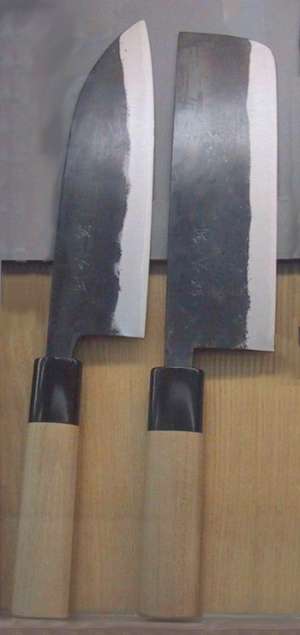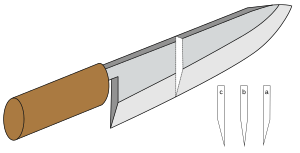Nakiri bōchō facts for kids

Nakiri bōchō (which means "knife for cutting greens") and usuba bōchō (meaning "thin knife") are special Japanese knives. They are designed for cutting vegetables. Unlike other knives like the deba bōchō, these knives have a straight blade. This straight edge helps you cut vegetables all the way to the cutting board without needing to pull or push the knife sideways.
Nakiri and usuba knives are also much thinner than other kitchen knives. A deba bōchō is thick and heavy, good for cutting through small bones. But its thick blade isn't great for vegetables because it can break delicate slices. Nakiri and usuba knives have very thin blades. This makes them perfect for slicing vegetables, but not for cutting bones in fish or meat.
Nakiri Bōchō: The Home Vegetable Knife

Nakiri bōchō are usually the knives you find in homes in Japan. Sometimes, their blades have a black finish called "Kurouchi."
The cutting edge of a nakiri knife is sharpened on both sides. This is called ryōba in Japanese. Having two sharpened sides makes it easier to cut perfectly straight slices of vegetables.
Usuba Bōchō: The Professional's Choice
Usuba bōchō are vegetable knives used by professional chefs. They are different from Nakiri bōchō in how their cutting edge is shaped.
While the nakiri bōchō is sharpened on both sides (ryōba), the usuba bōchō is sharpened on only one side. This style is known as kataba in Japanese. The best kataba blades even have a slight dip on the flat side.
This kataba style edge allows for very precise cuts and much thinner slices than the ryōba edge of a nakiri. However, it takes more skill to use an usuba knife correctly. Most usuba knives are sharpened for right-handed people. But you can also find knives sharpened for left-handed use.
Even though the usuba bōchō is heavier than a nakiri bōchō, it is still much lighter than a deba bōchō.
See also
 In Spanish: Nakiri bōchō para niños
In Spanish: Nakiri bōchō para niños

